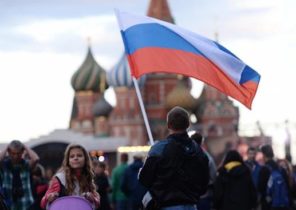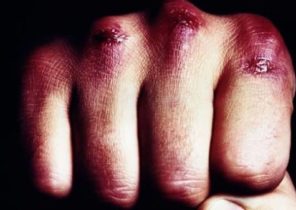
Robert Jensen (Robert Jensen) has built a career bringing order after major disasters: identifying the remains, taking care of the families of the victims and restoring their personal belongings. That’s how he became the best specialist in the world’s worst job.
The team stumbled, broke through the jungle. The group had little idea about where they go and what they find. A few days ago search planes flew high over the foothills of the Andes, spotted the wreckage of a crashed helicopter, littered the steep, rocky slope. To get to this chaos, the air was impossible, so the team had to dismount.
Group, pirouetting through the thickets, was led by Robert Jensen, a tall, strong man in a white helmet with the letters “BOB” scrawled in marker on the front. They had two days to fight the bushes to get to the place. Six days later, Jensen will be the last one to leave. With Jensen mining group Rio Tinto, who has hired a crashed helicopter to deliver employees with the Peruvian copper mine to the city of Chiclayo, was contacted first. What Jensen has developed a strategy on how to get to the crash site when it became clear that all ten people that were on Board were killed, and the wreckage scattered along a winding mountain ranges, tropical Yosemite. Jensen has assembled a team of two Peruvian police officers, two investigators, several forensic anthropologists and a group of national Park Rangers, accustomed to climbing mountains during search and rescue missions. They all knew that this expedition will not rescue.
Jensen, this is the man that companies call when it happens the worst. Under the worst means all the events that inspire such fear and panic that most people prefer not to think about them — for example, plane crash, terrorist attacks and natural disasters. Jensen doesn’t have any special gift to collect the bodies, identify belongings or to talk with members of the families of the victims. What he has is experience. During his long career, Jensen for decades earned a reputation as the best in this unusual case. As the owner of the company “international emergency services Kenyon” (Kenyon International Emergency Services), Jensen takes from 6 to 20 applications per year worldwide (2016 — 9, not counting those that continued in 2015). Because of his work he constantly finds himself sadly involved in the events, giving birth to the saddest headlines of modern history. He was engaged in grave Affairs after the terrorist attack in Oklahoma, he flew directly to the Pentagon after the events of September 11 and participated in the search for bodies, when was hurricane Katrina.
Helicopter crash in Peru in 2008, the international news is not horrible, but this mission became memorable for Jensen because of its complexity. Everything was sticky from the heat, everywhere lay in wait for the dangers of the jungle. Jensen decided that the team will move in pairs, for fear of Cougars and snakes. Before leaving he conducted a risk assessment and found out that this territory is home to 23 species of poisonous snakes. The antidote he only had three, so he called the members of his team to try unconscious to get a good look at exactly who they bite, if it happens.
They were there to collect all that is possible, personal belongings, fragments of skeletons, and any evidence that would help the families of the victims to understand how their home ended his days. Before to do all this, they had to get to the place. Jensen is working as efficiently as possible: all possible difficulties were already addressed and resolved in the military in cold blood. Jensen gave his team the task to begin to clear space for helicopter landing and mountain climbers — stretch rope up the slope so they can climb up and down. Every piece they collected into containers, then transfer to the archaeologist, who sifted them to find the bone fragments. Inexperienced glance it might seem that nothing of value it was impossible to find – the flight data recorder already recovered and it was clear that there were no survivors. Still, Jensen was looking for.
In total he and his team gathered on the mount 110 of the fragments of skeletons, and some personal belongings and recorder from the cockpit. The remains found by the Kenyon firm, allowed the identification of almost all who were on Board that when working with high-speed disaster — a rarity and a sign of mastery. Every night the team bury what they found, arranging minutes of silence. The next morning all the remains and personal effects exhuberantes and they were taken away by helicopter, and the team once again began to work.
After many days spent clearing the hillside, when they gathered all that he could, Jensen suddenly saw something high up in a tree up the side of a large piece of human tissue, hanging from a branch. To get there was incredibly risky, even with the help of ropes, but Jensen couldn’t leave the find. He climbed up, gathered found and placed in a plastic bag. His work was done. All he found will be handed to the families of the victims. “So they knew that the bodies of their loved ones were not just left to the jungle, recalls Jensen, a single piece”.
Jensen doesn’t have in stock heartbreaking stories of salvation. What is he looking for, a more abstract value — is the part of man, in the literal or figurative sense, he may return to the victim’s family, saying: “We tried”. He knows from experience that when someone’s life is ruined, even the smallest fragments can bring peace.
Many found Jensen and his team things went to the Kenyon office in Bracknell, a town an hour away from London, where roundabouts are not less than men. Outside and not to say that this building was constructed for a service that deals with the consequences of mass death of people. The facade of the building perfectly ordinary, rough concrete box, indistinguishable from the other surrounding offices. Small disco ball gleaming through the blinds of one of the office Windows. But behind the facade of an office building hiding a huge agarophobia the warehouse where collected personal belongings photographed identifitseerida and restored.
In perfect order on the metal shelves located throughout the warehouse, tools are needed for the myriad of tasks that Kenyon performs on duty. One closet contains all the clothes and such that Jensen should be handled promptly, every thing in the package is signed on the clasp. Here is everything you need for first aid of any type on the scene, and vests on occasions when Kenyon cause hot. There is a basket with prayer mats for Muslim families and a box of Teddy bears in t-shirts with the logo Kenyon for children in Centers family assistance. A truck with a refrigerated mobile morgue is located in the corner, its door ajar. One wall is seen the coffin, wrapped in a purple cloth — Jensen explains that this “trainer” for training team members, but it’s still ominous. Behind a Desk working in photoshop placing a photo of the found personal belongings on white background, to their families were easier to identify. On the roof of the drumming rain, but other than here there is a deathly hush.
Kenyon only recently moved into this room, favorites because of the proximity to Heathrow airport, but the firm Kenyon’s rich history. In 1906, Harold and Herbert Kanonov, sons of the Director of the English funeral home, was asked to help with the identification and delivery home of the 28 bodies of those killed in a train crash when a train came off the rails at Salisbury. Cagnoni as yourself and still call employees of the firm were set to work as soon as I heard the terrible news about a major disaster. Then they could not yet identify people by DNA. The victim was identified by fingerprints and dental records, if they had them, or for personal things if you don’t. At that time, as technology became more sophisticated catastrophe with massive loss of life became bigger. Air travel became faster and more accessible, and plane crashes have claimed more lives. Weapons were becoming more powerful. The need for specialists grew, and Kenyon has become an international company.
Most people today believe that this government work with the effects of major disasters. Often it is a great experience that Jensen was even before he started working at Kenyon in 1998, he received the U.S. Army mortuary Affairs (Army mortuary affairs handling). But this involved not only military Affairs is enough and for companies like Kenyon, not only because of their high competence, but due to the fact that it is useful to have at hand a team with no political affiliation. In 2004, after the tsunami in Thailand more than 40 countries have lost their tourists, and each has worked to return the bodies to their families. After the tsunami, bodies are not so easily identified, and ethnicity gives a poor idea of nationality: “I get Up in Phuket town and tell up all the Swedes. And no one will answer,” says Jensen. “We all have to work together.” Kenyon has provided equipment and worked as an honest broker, without giving privileges to any of the nationalities in front of the other.
Along with terrorism, is often the work of Jensen associated with the crash. Many passengers believe that in the case of the crash, the airline takes on many related responsibilities. More often than not, they do not. Airlines and governments keep companies like Kenyon at hand, because they can’t afford to make a mistake with such a responsibility. In addition to the ethical motives to act properly in relation to the victims ‘ families, at stake are huge financial loss in the event of poor work. Years of litigation and oppressive wave of negativity and complaints from disgruntled families can become critical. Malaysia Airlines, for example, barely coped with massive criticism over its responsibility for the tragedy with the aircraft MH370 and MH17 (Malaysia Airlines several times reminded me of Jensen, not the client Kenyon). The airline can reassign the Kenyon all; their services include the organization of call centers, identification and delivery of bodies home, mass graves and the recovery of personal belongings of the victims.
Some of the things that is expected from airlines in the event of a crash, fixed in the Federal law 20 years ago. Before the carriers got away with a rather erratic performance of their duties. Families who managed to achieve a tightening of Federal regulations on this issue have lost loved ones after the disaster with flight 427 U. S. Air airline, when in 1994 a plane crashed near Pittsburgh. According to heartbreaking letters from the families of the victims of the airline, U. S. Air reaction to the collapse was to put it mildly unsatisfactory.
“When it became clear that personal belongings were in garbage containers, — said one of the relatives of the deceased, — this was enough to piss off any indifferent person. Who decides which personal items are important and which are going in the trash? We are talking about human lives!! Sometimes the tag Luggage is the only thing that remains the man!”
Some countries are still falling behind in dealing with such situations. Mary Schiavo (Schiavo, Mary), aviation lawyer and former chief inspector of the Department of transport, told me that after one disaster in Venezuela, authorities conducted a negligent search of the remains, then dug up all that remains with an excavator from a nearby farm. “I don’t mean that someone is good enough or a bit, because, without a doubt, the people with whom I worked these years, tried to be kind and empathetic, treating the remains of the — said Mary Schiavo. But sometimes they did not have enough experience to give the right attention to detail, as did the national Council for transport safety or professional groups like Kenyon. More precisely, I mean just a group of Kenyon”. Kenyon is the difference between the ideal response and the ten-year trials.
When a commercial flight crashes, the client immediately informs Jensen. Usually the customer is the airline, although in some cases this may be a company like Rio Tinto or even the country where the plane fell. He gathers all the information possible. First, he tries to figure out who is responsible for what. Kenyon is a private company, so if the government decides to administer activities on liquidation of consequences, Jensen gives way to them, while being on hand for consultations. In a few minutes the phone conversation, Jensen learns enough information on the incident to understand what are the most urgent needs of the airline. The state Kenyon can swell with 27 full-time employees and 900 independent contractors hired on contract, depending on the severity of the disaster. The Kenyon team members are not working within the same industry, although many of them have experience in law enforcement. All have one thing in common: they are very empathic, while maintaining the ability to emotionally distance themselves from the victims of the disaster. “You shouldn’t have”, — reminds them Jensen. Jensen chooses not to maintain ties with the families of the victims, considering himself a kind of activator of their grief.
Each employee and team member has their responsibilities and they perform them as needed. In the long hallway of the building in Bracknell is the chart showing the order of action during a critical situation. It packs together a countless number of rounds with color coded and each represents work that needs to be done. At the top is a red ball, representing the senior coordinator of incidents — Jensen.
Around the world, members of the crisis communications team keep their phones nearby, ready to answer questions from the media. At this time, the liaison team at the hotels goes to the hotel, located near the crash site. The families of the victims from around the world fly to the disaster area, so the hotel must be large enough to accommodate them all. Just as families and staff of Kenyon reached the place, the hotel by mail or Fax gets a manual on how to pick up rooms and prepare them for grieving guests. For the next few days the hotel became the Center of the help to families, where the families of the victims will have to wait, to grieve together and to spend time between briefings as well as possible.
While his plan for the Centre for assistance to families enforced, Jensen is already on the way to the scene. As soon as Jensen will get an idea about the condition of the bodies, he starts to give instructions for the morgue. This is important not so much the number of victims, much as telephone the Crash of a small plane that crashed in Mozambique in 2013, for example, demanded more effort in organizing the collection and storage of bodies than unhappiness with the big commercial flights. Although killing all 33 passengers, there were 900 parts.
Jensen often has to act as a liaison between the families left the hotel, and specialists at the crash site. All the misery with the large number of deaths are different, but the Kenyon employees rarely work at the crash site alone — even in the case of the collapse of Rio Tinto in Peru, the government demanded that two Peruvian policemen have joined the team. Kenyon working together with local law enforcement agencies, medical examiners, firefighters and the military. Each of them works quickly to weather conditions did not cause more damage to vulnerable remains and personal belongings.
As soon as Jensen learns more details about the crash, he arranges a meeting for families of the victims. Such briefings are very hard. “You can’t undo what happened, so everything that is in your power is not to worsen the situation, Jensen says grimly. — You have a very heavy task.” Jensen desperately wants to give families at least a small glimmer of hope, but instead he should tell the ruthless facts. First, he warns the family that they have to hear very specific information. The parents take children out of the room. “You have to realize that there was a strike at high speed, and therefore your loved ones now look nothing like we, he says something like this. It means that we are likely to find several thousands of fragments of human remains”. At this point begins choking. Jensen pumped from the premises all hope. Now his job is to help them through the transformation.
Jensen does not use the expression about “tighten a wound.” “I do not see that the wound is healing, he says. I see a transformation from one normal state to a new normal state”. Transformation after losing someone is always difficult, but after the crash it still is fraught with any ambiguity. Families often do not receive the body or even remains for many weeks. Some never get. The lack of a body means the absence of certain information, to share it with interested relatives and friends, the opportunity to claim on the insurance and plan a funeral. The responsibilities that are associated with the loss of a loved one, seem a burden, there is no opportunity to fulfill them. All that the relatives of the deceased can do is to wait for the details.
When the remains and personal belongings collected from the crash site, collect kenyoni dental and other medical records and conduct long conversations with their families, trying to figure out any details that could help identify victims. Each family must choose one person who will get the found remains and personal belongings. Some disputes end up in court. Kenyon staff explain how the procedure is carried out with personal things and ask families the questions: whether they want to found items were cleaned? If they want to get them from hand to hand or in the mail? Jensen leaves every little thing to the discretion of the members of the families of the victims. They almost can not influence the circumstances which were, and decisions in connection with personal belongings return a feeling of control.
So families can decide not to participate in the process. Some personal things are irrelevant. For someone not important and remains. But almost all want to participate. Haley shanks (Shanks Hailey) was only four when her mother, a stewardess, was killed in the crash aboard Alaska 261 in 2000. Her grandmother had found something of my mother — a button from the forms and from the navel ring, and she never would have thought to pick them up. “I think the thought of having to throw away any memory of what happened, just couldn’t visit,” says shanks. Granny shanks keeps them in a little box in his bedroom. Sometimes shanks takes them, but the trauma of them, too tormenting her. However, she’s happy, grandma keeps them. “I think it is very sad that couldn’t be there — not in the sense that she wanted to be there but that her daughter was in that situation. I think any memory of her and what happened, very important in itself. Any piece of it.”
At the crash site of Jensen and his team are removing any hazardous substances that can cause further damage to things, but things fall into Bracknell in a different state. They are wet because of the weather and the water that extinguished the fire, they smell aviation fuel and decomposition. When the container is delivered, the team members carefully unpack each box and laid out the items on long tables in the middle of the room. Subjects are studied and divided into two groups: the “correlated” — with names of passengers on them, or things found near the body or on it, and “unmapped” — which rank all from of hours, found a pile of rubble, to the suitcase labeled with the name, which is not in the passenger list. Correlated items returned in the first place, and unmapped photographed and placed in the online directory, which can explore the families of the victims, hoping to find out some of the things.
Before folders of photos, it became possible to spread in the Internet, they were made on paper, with six or more items on each page. I spend hours to flip through one of these directories remaining after the crash that happened with a decade ago. Regardless of the purposes of creation, the directory gives an excellent idea of the style and popular culture of those times. There is music disc Jessica Simpson “Irresistible” and tainted the water the book of Ian Rankin. Some things are badly damaged. Blackened the designer “LEGO” and a few pages of glasses without glasses and terribly mangled the temples, as with Dali’s paintings. Here are a few black boxes with the Chef from “South Park” on the cover. Here is the page with wedding rings with engraving — Patricia, Marisa, Marietta, Laura, Giovanni and the little icon that looks like a plane. Next to each subject — the graph, which describes its state, and is everywhere marked as “damaged”.
When the families of the victims identificeret everything you can, from a catalog, Jensen continues to work on mapping the remaining things with the dead. He works relentlessly. He and his team use all possible evidence, including photos and recovered cell phone numbers. Jensen even brought car keys to dealers to try to get the VIN of the vehicle. Usually dealers can tell the only country that was sold the machine, but even that can be an important clue. For example, Jensen learned that a set of car keys was found after the crash Germanwing was from cars sold in Spain, which has significantly reduced the circle of victims, which they could belong.
Identification of personal belongings can be much more severe than identification. “When you examine the human remains, you need a physical examination, explains Jensen, You’re talking to family and asking them questions to gather information and to identify the person is not personalization. But when you’re dealing with personal things, you can learn all about the man. For example, what’s in your playlist? Of course, your goal is not to find out what they have in the playlist, you just learn what is on the computer to try to figure out who it is.” A body is a body, but the personal stuff is life. It is impossible to dissociate itself from the dead when you’re browsing for his or her wedding photos taken just a few weeks ago.
Jensen is faced with things that in other circumstances would have seemed outrageous to him personally. “You just think that this whole Luggage through security at the airport. Imagine all the different societies, religions and groups that represent the people who were on the plane. All this talk about their personal lives. You take the thing and think, “Oh, my God. Who might need it? Why do you need this picture or this book? Why have you supported this organization?”” About all these things, he cares not less, than about others “not Involved”.
Every stage of things is a decision which should make the family of the deceased. You can’t just assume that the relatives are going to want to clean things. Jensen tells the story of one woman who lost her daughter in the crash of flight Pan Am 103 when a plane exploded over Lockerbie in 1988. First, when the woman got things her daughter, she was upset that from them came the smell of fuel. It permeated the entire house. But after a while the woman began to appreciate him as last reminder of his daughter. “No one should be deprived of choice, because you can, for example, to meet a mother who will say: “I washed my son is 15 years old and I want the person who will wash his shirt for the last time, was I, not you””.
Many things found Jensen, will never be returned. After two years or whatever did the process of completion of the search the lost items collected by Jensen, will be destroyed. But the impressions and experience that he received will remain in memory and will often return to it and help.
Jensen, for example, knows why you should not inflate the lifejacket before leaving the sinking plane he visited the crash site where he saw a terrible picture floating inside the plane with bodies of people caught in the trap because of their vests, while the rest survived. He knows that it is useless to spend your life afraid to die during a disaster. He thinks about the woman whose body was found in the wreckage after the terrorist attack in Oklahoma. On one foot she had high-heeled shoes and other outdoor shoes. He realized that this woman just came into the office and change shoes. If it was late in the day for five minutes for work, she would still be alive.
Like others, Jensen thinks, how he would have felt and behaved at the end. “I know what kind of things belonging to my family members, I would like to have me back. I know, I’d like to get Brandon”, — he nods in the direction of her husband, the Executive Director of Kenyon, Brandon Jones. “Engagement ring, bracelets (Jones and Jensen are braided bracelets, given to each other) — special things. He might want to sell them,” he jokes.
Jones thinks for a moment. “Strange,” he says, ” I’m not afraid to fly. I began to look at life differently than I did before Kenyon. But I began to reassess the importance of things. For example, there are things that I always carry, they are always in my bag. The Souvenirs he brought me from places where we have been and are always with me. Things I may not see every day, but certainly always see when I look at the passport. And laying out my things on the plane, I think they would mean something to him that he would retain if they were returned to him”.
Work has taught Jensen that fear of disasters does not help, but he still always believes the door to the exit before you enter the hotel room, and while traveling on the plane, neither he nor Jones never take your shoes off before you turn off the sign “fasten your seatbelts” (most accidents happen during takeoff and landing, and do not want to be barefoot on the runway, if you have to run outside). I inquired if there was Jensen’s any secret how to keep calm, living in the age of terrorism, and here it is: allow yourself to worry about everyday worries and don’t waste time on horror.
Most families prefer to receive personal items through the mail, then wrapped them in white wrapping paper, if they are large, or laid out in small boxes. Some families want things to be delivered to them personally. And then it is very hard.
Once Jensen had to return the personal belongings of a young man who died in a plane crash. Early in the morning of that day, when disaster struck, he called his mother and said that getting on a plane. She found out later in the day, when I turned on the TV and saw that the plane fell into the ocean.
But after that, says Jensen, she still wasn’t sure. Could her son to swim to the nearest island? Maybe the coast guard check? They, of course, checked. A few days after the disaster almost all the passengers were identified by DNA samples, but none of the pieces of tissue did not belong to her son.
When personal belongings of passengers washed up on shore, the fishermen and the Sheriff took them. They found a few things of her son, including two water-soaked passport (one visa), and a suitcase that apparently belonged to him. The company called his mother and asked if she wants things to be delivered or sent by mail. She asked that someone brought, and Jensen volunteered to do it.
Jensen remembers how came to this woman’s house and saw that the truck is her son still is at home. His room hasn’t been touched since the moment he set out on his journey. The woman left work and lived in suspended animation. “She could not cope, says Jensen. — There was no evidence. No body”. Jensen and one of his employees cleared the table and covered it with a white cloth. They asked mother to go out and began to unpack her son. Covered them to view all things at once too did not hit her. Asked her to come in.
They showed mother two passports. She dropped her head in her arms and rocked back and forth. The next thing amazed Jensen. Opening the suitcase, they found a set of orange curlers, the kind that mother used Jensen in the 70’s. the young man had short hair — it was very strange. Jensen suggested that a fisherman found a suitcase half open and put it in a thing of another passenger. “Please don’t be offended,” said he, taking out curlers.
The woman looked on the curler. She said they belonged to her son. He took to borrow suitcase for her mother, in which she kept her curlers. He knew, as they mean a lot to his grandmother, the woman told Jensen. He was not anywhere to put them, and just left in its place. Jensen remembers how she looked at him then: “So, Robert, you mean to tell me that my son’s not coming home”.







